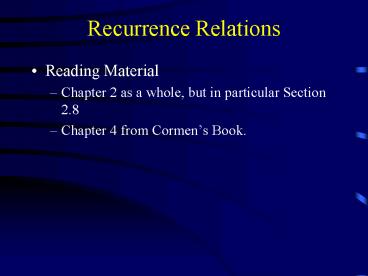Recurrence Relations PowerPoint PPT Presentation
1 / 15
Title: Recurrence Relations
1
Recurrence Relations
- Reading Material
- Chapter 2 as a whole, but in particular Section
2.8 - Chapter 4 from Cormens Book.
2
Recurrence Relations
- Objective To discuss techniques for solving
recurrence relations. - These techniques will be very important and
handy tools for analyzing algorithms that are
recursive. - Linear Homogenous Recurrences
- Characteristic Equations
- Inhomogeneous Recurrences
- The Master Theorem
- Recurrence Expansion
- The Substitution Method
- The Change of Variable Method
3
Linear Homogeneous Equations
- Definition A recurrence relation is called
linear homogeneous with constant coefficients if
it is of the form - We restrict our discussion to homogeneous
recurrence equations with k1 or k2
4
Solution of Linear Homogeneous Equations
- When k1, and hence
the solution is - When k2,
- the following steps are followed to solve the
recurrence - Find r1 and r2, the solutions to the
characteristic equation - If r1 r2 r, then
- Otherwise
- Determine c1 and c2 from the initial values f(n0)
and f(n01)
5
Examples
6
Inhomogeneous Equations
- Definition A recurrence relation is called
inhomogeneous if it is not a homogeneous
recurrence relation. In particular, we will look
at - where ?i 1 ? i ? k ? gi(n) is not a constant or
g0(n) ? 0.
7
Solution for Inhomogeneous Recurrences
- No general method for solving inhomogeneous
recurrences exists. However, - There are cases where a formula for a class of
inhomogeneous recurrence relations exists (Master
Theorem) - The rest depend on experience and/or trial and
error in choosing one of the following techniques - Expansion
- Substitution
- Change of variable
8
Master Theorem
- Theorem Let a?1 and bgt1 be constants, let g(n)
be a function, and let f(n) be defined on the
nonnegative integers by the recurrence - where we interpret n/b to mean either ?n/b? or
?n/b?. Then f(n) can be bounded asymptotically as
follows - If ??gt0 ? g(n)O(nlogba - ?), then f(n)
?(nlogba). - If g(n) ?(nlogba), then f(n) ?(nlogba log n).
- If ??gt0 ? g(n)?(nlogba ?), and if ?clt1, n0?? ?
ag(n/b) ? cg(n) ?n gt n0, then f(n) ?(g(n)).
9
Examples
10
Gaps in the Master Theorem
- The three cases in the theorem do not cover all
the possibilities for g(n). There are gaps
between cases 1 and 2, and 2 and 3. - For example, can we apply the Master theorem on
the following recurrence?
11
The Expansion Method
- When expanding few terms of some recurrences, a
solution may become more apparent. - Example Consider the previous recurrence
12
The Substitution Method
- If we can have a good guess of what the answer
may be, then we can use mathematical induction to
prove that it is correct. - Example Consider the following recurrence
- This recurrence seems similar to
(when n is a power of 2, they are
exactly equal.) By applying case 2 of the master
theorem, the solution to the second recurrence is
?(nlog n). Therefore, we can guess that we can
find c,d gt 0 ? dnlog n ? f(n)2f(?n/2?) n ?
cnlog n for all values of n.
13
Example (Cont.)
- We show by induction that f(n) ? cnlog n . The
other inequality is left as an exercise. - Induction Step
- Initial Step
14
The Change of Variables Method
- The idea is to change the domain of the function
and define a new recurrence in the new domain
whose solution may be easier to obtain or is
already known. Once the solution is obtained, we
convert the domain of the function back to its
original domain.
15
Example

